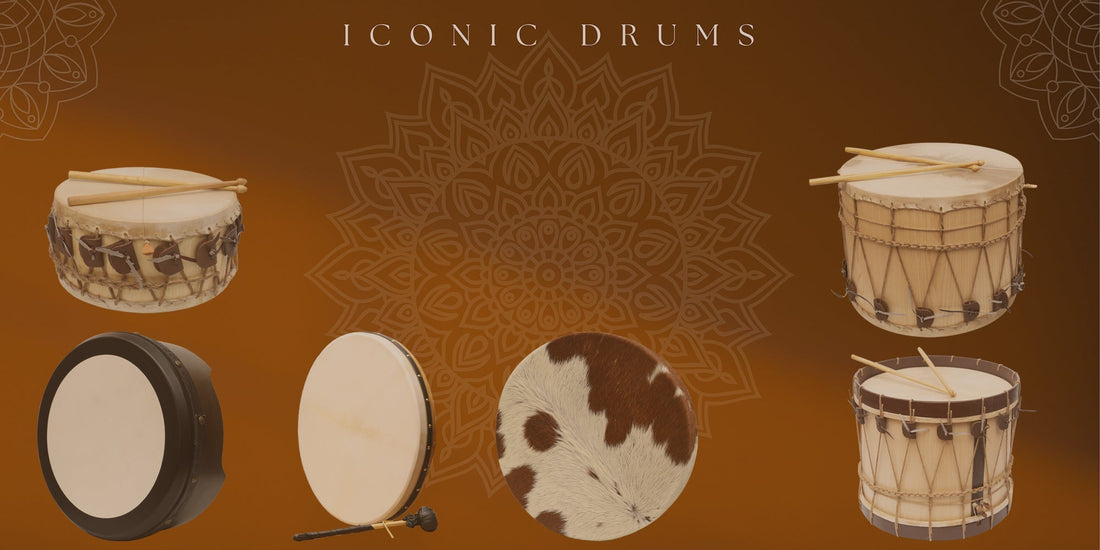Drums have always been more than musical instruments. Across cultures and centuries, they have served as tools for communication, markers of ritual, symbols of power, and sources of rhythm in dance and warfare. While modern drum kits dominate popular music, traditional drums still echo with the spirit of the communities that shaped them. This article explores six of the most iconic drums in world history, focusing on their construction, cultural roles, and distinctive sounds. These instruments are not only preserved in museums but also played today by musicians, folklorists, and historical performers.
The Bodhrán: Ireland’s Rhythmic Pulse
The Bodhrán is widely considered the voice of Irish traditional music. Circular in shape and typically made from a wooden frame with a goatskin head, the bodhrán is a deceptively simple drum. Its real power lies in how it is played.
Using a small wooden stick called a cipín, the player can generate a wide spectrum of sounds, from deep, earthy pulses in the center to bright, sharp strikes near the rim. Skilled players also manipulate pitch and tone by placing their non-playing hand against the inside of the drum skin, adding nuance and melodic shape to the rhythm.
The bodhrán was once believed to be a farm tool used for separating chaff from grain. Over time, it made its way into music and eventually took center stage in Irish folk revival movements. Today, it remains a fixture in both solo and ensemble performances. A wide range of bodhráns, including tunable options and handcrafted models, are available for those looking to explore this instrument further.
🔗 Shop Bodhrán
Frame Drums: Echoes from the Oldest Traditions
Among the earliest drums ever created, the frame drum has left its mark across continents. Used in Mesopotamia, India, the Mediterranean, and beyond, it often featured in spiritual and ceremonial settings. Its construction is simple, a round wooden frame with a stretched animal skin, but its sound is rich, resonant, and expressive.
Unlike drums struck with sticks, frame drums are usually played with the hands. This allows for subtle articulations such as finger rolls, muted slaps, and varied dynamics that range from soft whispers to commanding beats. Because of its direct connection to the player’s hands, it often feels more intimate than other percussion instruments.
In many cultures, including those practicing shamanism and Sufi mysticism, the frame drum serves as a bridge between the human and the divine. It is still used today in healing ceremonies, traditional music ensembles, and experimental world music. Those interested in owning a piece of this global heritage can explore a variety of Frame Drums & Shaman Drums available through specialist makers.
🔗 Shop Frame Drums & Shaman Drums
The Tabor: A Portable Powerhouse of Rhythm
The Tabor Drum emerged in medieval Europe and quickly became a popular companion to the pipe, a small three-holed flute. What set the tabor apart was that both drum and flute could be played by a single performer, often during festivals, public announcements, and military events.
Small in size and suspended by a strap from the shoulder or arm, the tabor is a double-headed drum played with a single stick. It produces a clear, dry tone designed to carry across open spaces. Its use was functional as much as it was musical, serving to direct troops, entertain crowds, and accompany dances.
While the tabor has faded from mainstream music, it remains active in historical reenactments and traditional performances in regions like southern France and England. For musicians seeking historically accurate instruments, a selection of handcrafted tabor drums is available, designed to match original specifications in both look and sound.
🔗 Shop Tabor Drum
The Davul: Pulse of the Ottoman March
Medieval Drums: The Power and Precision of Battlefield Sound
Among the standout percussion instruments of medieval Europe and the surrounding regions, the large rope-tensioned drum held a commanding presence. Known in various forms across the Balkans and Anatolia, drums like the davul were central to both military operations and folk celebrations. Played with contrasting beaters, one thick to emphasize the low-end thump and one thin for sharp, crisp strikes, these drums created a layered rhythm that could be heard across vast outdoor spaces.
In Ottoman military tradition, this type of drum formed the rhythmic backbone of the mehter band, widely recognized as the earliest organized military marching ensemble. Its deep, booming tones served not only to inspire troops but also to intimidate opposing forces during campaigns and ceremonial displays.
Though not always labeled under the same name, comparable instruments are available in the Medieval Drum Collection, featuring traditional construction methods and robust sound suitable for both reenactment and live performance. These drums bring the character of medieval music to life with authenticity and strength.
🔗 Shop Medieval Drum
The Renaissance Drum: A Courtly Companion
The Renaissance Drum represents a shift in drumming from battlefield to ballroom. Larger and deeper than the tabor, this rope-tensioned drum was often equipped with gut snares to enhance its tonal range. It featured prominently in ceremonial music, early orchestras, and courtly dance settings during the Renaissance period.
Played with two sticks, the Renaissance drum provided not only rhythm but also a visual spectacle. Its decorative ropes and painted shells made it a favored instrument for processions and celebrations. The drum’s deep tone and responsive snare made it versatile enough to support both powerful marches and elegant dances.
For today’s historical performers, collectors, and educators, the Renaissance drum remains an important link to early European music. The available instruments offer both authenticity and performance quality, making them ideal for early music ensembles and period-themed events.
🔗 Shop Renaissance Drum
The Tabor-Renaissance Hybrid: Tradition Reimagined
As musicians seek instruments that bridge the gap between tradition and usability, the blend of tabor and Renaissance drum features has become increasingly popular. These hybrid models often retain the compact, portable design of the tabor while incorporating tunable ropes and snare systems inspired by Renaissance drums.
This combination allows performers to explore a broader dynamic range while maintaining historical visual appeal. Whether used in educational settings or live performance, these drums offer a practical solution for those interested in authentic sound and efficient handling. Modern makers now offer tabor drums with these hybrid features, enabling a balance of heritage and functionality.
Materials and Craftsmanship
One of the unifying qualities of these historical drums is the care and craftsmanship involved in their construction. Most are made using traditional materials such as natural animal skins, solid wood shells, and rope tensioning. These choices directly affect the instrument’s tone, response, and durability.
For those looking to maintain or upgrade their instruments, high-quality Drum Heads are essential. Replacing synthetic heads with authentic goat or calf skin can significantly improve tonal warmth and resonance. Whether repairing an old drum or customizing a new one, investing in the right materials ensures the instrument remains true to its roots.
🔗 Shop Drum Heads
Final Words
Drums have played many roles throughout history. From Ireland’s bodhrán to the battlefield davul, from Renaissance elegance to the raw power of the frame drum, each of these instruments has helped shape musical traditions that continue today. They speak not only through their rhythms but also through the materials, techniques, and rituals that have been passed down over generations.
These drums are more than historical artifacts. They are living instruments, still built, played, and appreciated by musicians around the world. For those seeking to explore this rich heritage, playing one of these drums offers a direct connection to the rhythms of the past.

